

Image source: Getty Images
Tesco (LSE: TSCO) has been in the news a good bit in recent weeks. Much of it relating to various criticisms of the company.
However, last Friday was an opportunity to reassure shareholders, as it released its first-quarter results and held its AGM.
A call with reporters, arranged for the same day, also provided it with a wider platform to not only add colour to the financial update, but also address some of the criticisms it’s been facing.
Tesco’s shares are higher than when I last sang its praises. Given the latest results, and current criticisms, is the stock still a bargain?
Criticisms
Customers have been up in arms about recent changes to Tesco Clubcard. These changes have had the effect of downgrading loyalty rewards.
John Allan, who was forced to resign as chairman last month amidst allegations of inappropriate personal conduct, has complained Tesco treated him unfairly. He told Sky News “the simplest and easiest thing was to propel me under the nearest bus.”
On a wider front, critics have accused supermarkets of ‘greedflation’ — exploiting the inflationary backdrop to make excessive profits.
Bank of England governor Andrew Bailey has stuck his oar in, and the competition regulator has launched a formal investigation into whether supermarkets have been ripping-off shoppers.
I’ll come back to these criticisms, but let’s first have a look at the first-quarter results.
Strong performance
Tesco reported an 8.2% rise in like-for-like group retail sales. The UK led the way with growth of 9%.
The company maintained its market share at 27.1%. It put this down to a strong volume response to its Low Everyday Prices price-lock on over 1,000 products and a further increase in Aldi Price Match to 700 products.
In addition, it said it enjoyed a ninth consecutive period of switching gains from premium retailers. Its Finest range performed strongly, with sales up 14.9% and over 100 new Finest products launched.
In the current cost-of-living crisis, it seems the company is successfully offsetting any customer leaks to discounters Aldi and Lidl with incoming spend from shoppers trading down from the likes of Waitrose and Marks & Spencer.
Guidance maintained
Tesco’s strong sales performance is all well and good, but the company doesn’t give profit and cash flow numbers in its quarterly trading statements. We’ll have to wait for the half-year results in October for those.
Encouragingly though, management reiterated its full-year guidance of broadly flat operating profit and free cash flow within a target range of £1.4bn to £1.8bn.
Criticisms revisited
Returning to the recent criticisms of Tesco, I don’t think the changes to Clubcard will have any major impact. It still offers shoppers significant attractions and rewards.
I also think ex-chairman John Allan’s gripe over his treatment is a bigger issue for him than for Tesco. Chief executive Ken Murphy told reporters it was “a difficult decision” but that Tesco’s board had “acted in the best interests” of the company. Exactly what directors are required to do.
Profiteering
Murphy had a lot more to say in defending the company against accusations of greedflation.
He said the British Retail Consortium’s food inflation figure for May (15.4%) was not what Tesco shoppers had experienced. Tesco had seen “encouraging early signs that inflation is starting to ease,” and was passing down lower prices to customers.
He said it had recently cut the price of own-label bread by 12% and pasta by 16%, and also lowered the price of breakfast cereals as wheat prices have come down.
Furthermore, he made a compelling argument that Tesco hadn’t indulged in greedflation when prices were rising: “The year before we had operating profits of about 4.4p in the pound and this last year it was down to 3.8p, so we don’t believe that would be called profiteering.”
Still a bargain?
When I wrote about Tesco last October, the shares were trading at 200p. If, like me, you believe Tesco has the right strategy for long-term success, you might well have been inclined to see value in the stock.
Today, the shares are around 260p. They may not be quite such a bargain, but I don’t see them as prohibitively expensive. Especially not for a dominant player in a resilient market sector.
The stock is priced at 11.8 times earnings with a dividend yield of 4.2%. This compares favourably with the FTSE 100‘s 14.5 times earnings and 3.8% yield.
If the market were to re-rate Tesco to the same earnings multiple as the Footsie, its share price would begin with a ‘3’ rather than the current ‘2’.





